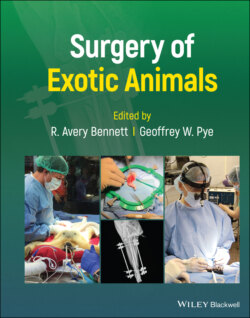Читать книгу Surgery of Exotic Animals - Группа авторов - Страница 63
Fish
ОглавлениеOf all exotic species commonly kept as pets, fish represent the largest group with over 75 million fish kept in nearly 8% of US households (Shepherd 2008). Despite their popularity, veterinarians play a limited role in health care, and few studies exist examining tissue reaction to suture materials in fish (Gilliland 1994; Hurty et al. 2002; Deters et al. 2009).
A single study evaluated the histopathological reaction to different suture materials (Hurty et al. 2002). Five different suture materials (silk, monofilament nylon, polyglyconate, polyglactin 910, and chromic gut) were placed in the skin and body wall of koi (Cyprinus carpio). Biopsies of the sutured tissues were taken 7 and 14 days following implantation and evaluated for inflammation. Silk caused an inflammatory response that increased from 7 to 14 days and was the suture with the highest inflammation score at 14 days. The synthetic sutures induced a moderate inflammatory response at 7 days with a decrease in inflammation at 14 days. Polyglactin 910 caused a higher inflammation score at 7 days compared to polyglyconate. Monofilament nylon produced a moderate, sustained inflammatory response over the study period. Chromic gut produced a significant inflammatory response at 7 days and all sutures had been extruded out by 14 days.
Other studies evaluating suture material in fish used gross inflammation and suture retention to evaluate suture materials (Gilliland 1994; Deters et al. 2009). Healing response and suture absorption using four suture materials (gut, chromic gut, polyglactin 910, and polydioxanone) were evaluated in largemouth bass for 8 weeks following surgery to obtain liver biopsies (Gilliland 1994). Gut sutures were completely absorbed at 5 weeks, and incisions were healed at 6 weeks. Polyglactin 910 sutures were completely absorbed by 7 weeks and incisions were healed by 8 weeks. All polydioxanone sutures were intact at the end of the evaluation period, and all incisions in this group were healed at 3 weeks.
Seven suture materials (monofilament nylon, poliglecaprone 25, braided nylon, polyglactin 910, coated polyglactin 910 [Vicryl Rapide, Ethicon Inc., Cincinnati, OH], polyglactin 910/triclosan, and silk) were evaluated in Chinook salmon (Oncorhynchus tshawytscha) (Deters et al. 2009). Functional suture retention was assessed for all fish and was defined as suture that was present in the fish, remained knotted, and did not tear through the body wall of the fish. Poliglecaprone 25 exhibited greater suture retention than all other suture types and braided nylon had significantly lower retention than all other suture types at 7 days following implantation. Monofilament sutures had better retention than all braided sutures at 14 days. Inflammation scores were lower for monofilament nylon, braided nylon, and poliglecaprone 25 than all other suture types at 7 and 14 days following implantation.
In Siberian sturgeon (Acipenser baerii), antibacterial poliglecaprone 25, poliglecaprone 25, polyglactin 910, and polypropylene were evaluated for celiotomy closure (Boone et al. 2010). Polypropylene exhibited expected retention, but polyglactin 910 also exhibited suture retention up to 12 weeks. Polyglactin 910 caused higher rates of suture loss and dehiscence throughout the initial eight weeks. It was concluded that antibacterial poliglecaprone 25 or poliglecaprone 25 appear more appropriate for celiotomy closure in Siberian sturgeon.
Based on these studies, synthetic monofilament absorbable sutures appear to be the optimal suture material in fish. Unfortunately, there were no direct comparisons made between polyglyconate, polydioxanone, and poliglecaprone 25 in each study to determine which is best suited in teleost fish.
Three different suture patterns (simple interrupted, interrupted horizontal mattress, and subcuticular) were used to close full thickness coelomic incisions (skin and body wall) in goldfish (Carassius auratus) (Nematollahi et al. 2010). The interrupted horizontal mattress induced a moderately severe to severe inflammatory response and necrosis, but the subcuticular suture induced a very mild to mild inflammatory response. The simple interrupted suture induced a moderate to moderately severe inflammatory response. It was concluded that a subcuticular suture is the most appropriate to use in the closure of a full thickness body wall incision in goldfish.
Nylon suture has been recommended to close the shark coelomic cavity (Lloyd and Lloyd 2011).
